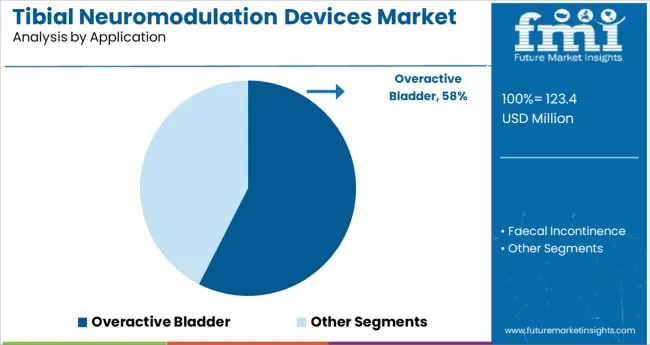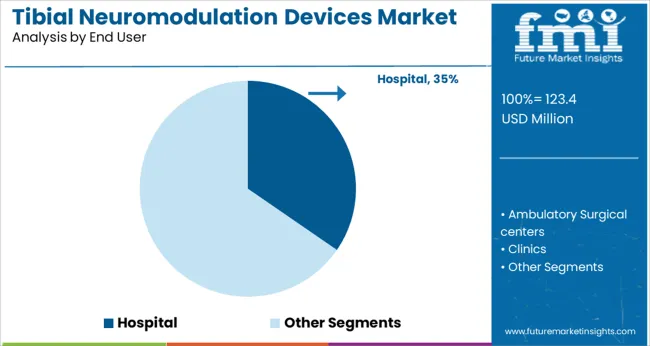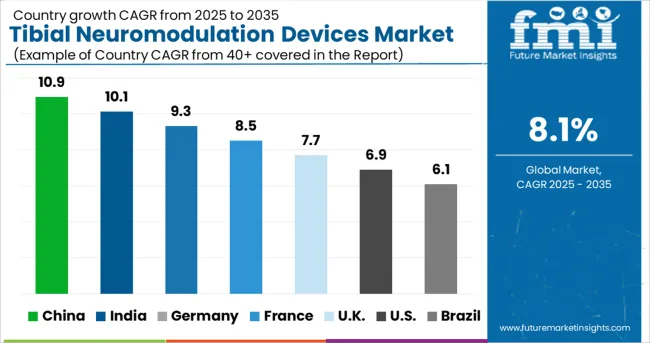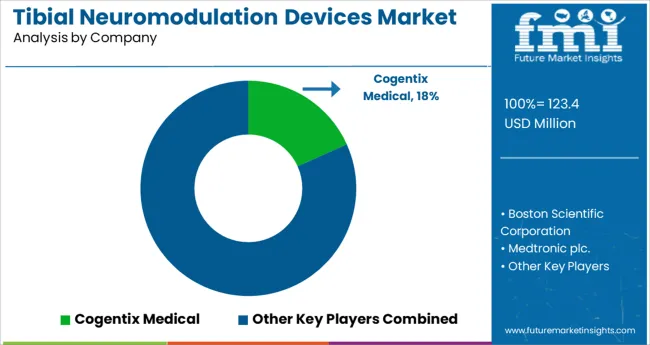The Tibial Neuromodulation Devices Market is estimated to be valued at USD 123.4 million in 2025 and is projected to reach USD 268.9 million by 2035, registering a compound annual growth rate (CAGR) of 8.1% over the forecast period.

The tibial neuromodulation devices market is undergoing strong expansion as demand for non pharmacological treatment of urological disorders continues to rise. Increasing diagnosis of overactive bladder and the shift towards less invasive neuromodulation therapies are central to the market’s current momentum.
Healthcare providers are adopting tibial nerve stimulation due to its favorable safety profile, outpatient applicability, and growing clinical validation in managing chronic bladder dysfunction. The devices are being integrated into outpatient care models and ambulatory surgical workflows, supported by technological improvements that offer portable, patient controlled systems with minimal procedural time.
The growing geriatric population and increasing awareness of neuromodulation alternatives among urologists and patients alike are enhancing treatment uptake. As device miniaturization, wireless connectivity, and personalized stimulation protocols become standard, the market is expected to witness broader penetration across secondary care centers and international markets.
The market is segmented by Application and End User and region. By Application, the market is divided into Overactive Bladder and Faecal Incontinence. In terms of End User, the market is classified into Hospital, Ambulatory Surgical centers, Clinics, Specialty Care Unit, and Others. Regionally, the market is classified into North America, Latin America, Western Europe, Eastern Europe, Balkan & Baltic Countries, Russia & Belarus, Central Asia, East Asia, South Asia & Pacific, and the Middle East & Africa.

Overactive bladder is projected to account for 57.5% of the total revenue share in 2025, establishing it as the dominant application segment. This leadership is supported by the high prevalence of overactive bladder among aging populations and the limited long term effectiveness of pharmacological treatments.
Tibial neuromodulation has emerged as a preferred therapeutic alternative due to its minimally invasive nature, durable symptom relief, and favorable side effect profile. Clinicians are increasingly recommending the modality in cases where patients experience poor tolerance to antimuscarinics or beta 3 agonists.
Advancements in device usability, such as simplified interfaces and wearable models, have improved adherence and outcomes in overactive bladder treatment pathways. The sustained demand for safe and effective second line therapy is expected to reinforce this segment’s leading share through 2025 and beyond.

Hospitals are projected to hold 34.6% of the market revenue in 2025, making them the leading end user segment in the tibial neuromodulation devices market. This prominence is attributed to hospitals' capacity to offer advanced urological services, manage complex patient profiles, and provide comprehensive diagnostics prior to initiating neuromodulation therapy.
Multidisciplinary care teams and reimbursement infrastructure within hospitals have enabled greater procedural volumes and streamlined patient onboarding. The availability of trained urologists, access to sterile environments, and integration of supporting technologies such as ultrasound and EMG monitoring have made hospitals the preferred setting for initial device implantation and therapy titration.
Additionally, hospitals play a critical role in clinical research and adoption of next generation devices, further solidifying their contribution to early market leadership and expanded clinical acceptance.
The rising frequency of chronic conditions, combined with the limits of pharmaceutical medications in effectively treating these diseases, has propelled the demand for tibial neuromodulation devices. The functional capabilities of various nerves in the human body, as well as the consequences of electrical stimulation of these nerves for the therapy of various illnesses, have been continuously explored.
As a result, new strategies and gadgets for addressing and treating chronic illnesses have emerged, boosting the tibial neuromodulation devices market growth.
These treatments range from spinal cord stimulation for pain relief to vagus nerve stimulation for epilepsy and other diseases. The tibial neuromodulation devices market is characterized by the introduction of specialized devices and methodologies to treat specific illnesses, as well as ongoing improvements in neurostimulation techniques.
A considerable proportion of patients suffering from chronic diseases such as chronic back pain, depression, epilepsy, and sleep apnea, among others, are resistant to treatment and drugs. Resistance is seen in the treatment's slow progression and delayed or limited consequences. As a result, healthcare professionals are moving their focus to neurostimulation approaches for chronic disease treatment, which is driving the sales of neuromodulation devices during the forecast period.
According to the Centers for Disease Control and Prevention (CDC), an estimated 50 million people in the United States suffer from chronic pain each year, with an additional 19 million suffering from severe chronic pain. Epilepsy, treatment-resistant depression, and other chronic illnesses impose a significant financial burden on countries. As a result, the tibial neuromodulation devices market share is anticipated to rise significantly during the forecast period.
In growing countries such as China, Brazil, and India, the prevalence of neurological diseases such as epilepsy, depression, and others is increasing at a rapid pace. Despite a higher frequency, lower diagnostic rates in developing nations limit the number of individuals who require treatment. As a result of this, the sales of tibial neuromodulation devices are anticipated to decline over the forecast period.
Lower diagnosis rates in these nations are caused by a variety of causes, including a general lack of awareness and limited access to diagnostic facilities due to inadequate healthcare infrastructure. This is exacerbated by the fact that a percentage of the diagnosed population does not receive treatment for a variety of reasons. These are some of the primary factors restricting the number of patients receiving treatment, hence limiting the tibial neuromodulation devices market growth.

North America is projected to hold 34.1% of the tibial neuromodulation devices market share during the forecast period. The primary reasons for the high demand for tibial neuromodulation devices in the region include higher rates of diagnosis and treatment among the patient population, as well as increased adoption of neuromodulation devices for the treatment of chronic illnesses. This is exacerbated by the larger prevalence of chronic illnesses in the United States, as well as suitable reimbursement regulations for these devices in the country.
Europe is projected to dominate the tibial neuromodulation devices market with a share of 40.1% during the forecast period. Major factors propelling the tibial neuromodulation devices market share in Europe include a well-developed healthcare infrastructure, combined with an increase in non-invasive device approvals in the region. As a result of these factors, the sales of tibial neuromodulation devices are projected to grow rapidly from 2025 to 2035.
From 2025 to 2035, new entrants and regional players are projected to get their CE mark approvals for their non-invasive devices which is further expected to boost the tibial neuromodulation devices market growth in Europe.
How are New Entrants Revolutionizing the Tibial Neuromodulation Devices Market?
The start-up ecosystem in the tibial neuromodulation devices market is moderate with a few startups conducting clinical trials to determine the therapeutic efficacy of their products. Deep Brain Innovations LLC, Scion NeuroStim, and ALEVA NEUROTHERAPEUTICS SA are some of the startups in the tibial neuromodulation devices market.

Who are some of the Key Market Players in the Tibial Neuromodulation Devices Market?
The neuromodulation devices market is consolidated, with the top four firms accounting for more than 90% of the market in 2025. Medtronic's extensive portfolio, along with strong brand awareness, widespread regional presence, and a solid distribution network, is responsible for propelling the business to market leadership in 2025.
The key market players profiled in the report include Cogentix Medical, Palex Medical SA, and Medtronic plc. Rainbow Medical Group. The key players in this market adopted product launch, partnership, and expansion as their key strategies to meet the changing consumer demands.
Recent Developments in the Tibial Neuromodulation Devices Market:
| Report Attribute | Details |
|---|---|
| Growth Rate | CAGR of 8.1% from 2025 to 2035 |
| Base Year for Estimation | 2025 |
| Historical Data | 2020 to 2024 |
| Forecast Period | 2025 to 2035 |
| Quantitative Units | Revenue in million and CAGR from 2025 to 2035 |
| Report Coverage | Revenue Forecast, Volume Forecast, Company Ranking, Competitive Landscape, Growth Factors, Trends, and Pricing Analysis |
| Segments Covered | Application, End-User, Region |
| Regions Covered | North America; Latin America; Europe; East Asia; South Asia; Oceania; Middle East and Africa |
| Key Countries Profiled | United States of America; Canada; Brazil; Argentina; Germany; United Kingdom; France; Spain; Italy; Nordics; BENELUX; Australia & New Zealand; China; India; ASIAN; GCC Countries; South Africa |
| Key Companies Profiled | Cogentix Medical, Palex Medical SA, Medtronic plc. Rainbow Medical Group. |
| Customization | Available Upon Request |
The global tibial neuromodulation devices market is estimated to be valued at USD 123.4 million in 2025.
It is projected to reach USD 268.9 million by 2035.
The market is expected to grow at a 8.1% CAGR between 2025 and 2035.
The key product types are overactive bladder and faecal incontinence.
hospital segment is expected to dominate with a 34.6% industry share in 2025.






Our Research Products

The "Full Research Suite" delivers actionable market intel, deep dives on markets or technologies, so clients act faster, cut risk, and unlock growth.

The Leaderboard benchmarks and ranks top vendors, classifying them as Established Leaders, Leading Challengers, or Disruptors & Challengers.

Locates where complements amplify value and substitutes erode it, forecasting net impact by horizon

We deliver granular, decision-grade intel: market sizing, 5-year forecasts, pricing, adoption, usage, revenue, and operational KPIs—plus competitor tracking, regulation, and value chains—across 60 countries broadly.

Spot the shifts before they hit your P&L. We track inflection points, adoption curves, pricing moves, and ecosystem plays to show where demand is heading, why it is changing, and what to do next across high-growth markets and disruptive tech

Real-time reads of user behavior. We track shifting priorities, perceptions of today’s and next-gen services, and provider experience, then pace how fast tech moves from trial to adoption, blending buyer, consumer, and channel inputs with social signals (#WhySwitch, #UX).

Partner with our analyst team to build a custom report designed around your business priorities. From analysing market trends to assessing competitors or crafting bespoke datasets, we tailor insights to your needs.
Supplier Intelligence
Discovery & Profiling
Capacity & Footprint
Performance & Risk
Compliance & Governance
Commercial Readiness
Who Supplies Whom
Scorecards & Shortlists
Playbooks & Docs
Category Intelligence
Definition & Scope
Demand & Use Cases
Cost Drivers
Market Structure
Supply Chain Map
Trade & Policy
Operating Norms
Deliverables
Buyer Intelligence
Account Basics
Spend & Scope
Procurement Model
Vendor Requirements
Terms & Policies
Entry Strategy
Pain Points & Triggers
Outputs
Pricing Analysis
Benchmarks
Trends
Should-Cost
Indexation
Landed Cost
Commercial Terms
Deliverables
Brand Analysis
Positioning & Value Prop
Share & Presence
Customer Evidence
Go-to-Market
Digital & Reputation
Compliance & Trust
KPIs & Gaps
Outputs
Full Research Suite comprises of:
Market outlook & trends analysis
Interviews & case studies
Strategic recommendations
Vendor profiles & capabilities analysis
5-year forecasts
8 regions and 60+ country-level data splits
Market segment data splits
12 months of continuous data updates
DELIVERED AS:
PDF EXCEL ONLINE
High Tibial Osteotomy (HTO) Plates Market Growth – Trends & Outlook 2025-2035
China High Tibial Osteotomy (HTO) Plates Market Insights – Size, Trends & Forecast 2025-2035
India High Tibial Osteotomy (HTO) Plates Market Insights – Trends, Demand & Forecast 2025-2035
Japan High Tibial Osteotomy (HTO) Plates Market Analysis – Demand, Trends & Forecast 2025-2035
Canada High Tibial Osteotomy (HTO) Plates Market Report – Trends, Demand & Forecast 2025-2035
Implantable Tibial Neuromodulation Market Forecast and Outlook 2025 to 2035
United States High Tibial Osteotomy (HTO) Plates Market Insights – Growth, Share & Forecast 2025-2035
Neuromodulation Devices Market
FBAR Devices Market
Snare devices Market
C-Arms Devices Market Size and Share Forecast Outlook 2025 to 2035
Timing Devices Market Analysis - Size, Growth, & Forecast Outlook 2025 to 2035
Spinal Devices Market Size and Share Forecast Outlook 2025 to 2035
Hearing Devices 3D Printing Market Size and Share Forecast Outlook 2025 to 2035
Medical Devices Market Size and Share Forecast Outlook 2025 to 2035
Network Devices Market Size and Share Forecast Outlook 2025 to 2035
Medical Devices Secondary Packaging Market Analysis by Material and Application Through 2035
Hearable Devices Market Size and Share Forecast Outlook 2025 to 2035
Lab Chip Devices Market Size and Share Forecast Outlook 2025 to 2035
Orthotic Devices, Casts and Splints Market Size and Share Forecast Outlook 2025 to 2035

Thank you!
You will receive an email from our Business Development Manager. Please be sure to check your SPAM/JUNK folder too.
Chat With
MaRIA